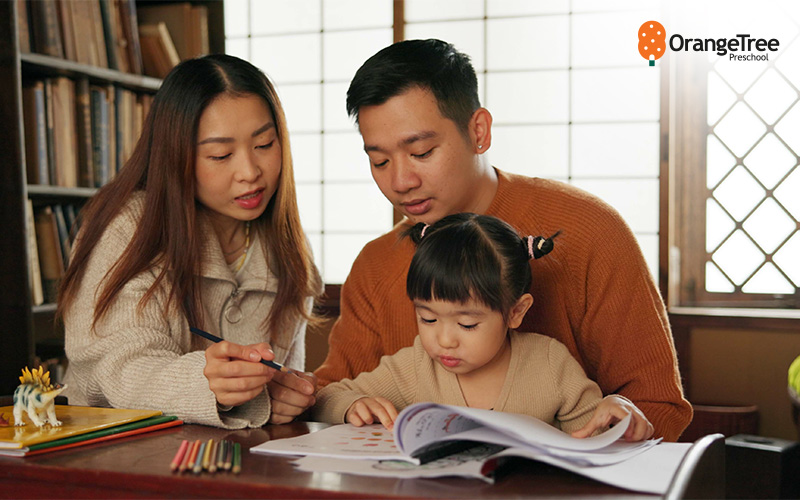
Bilingual Explained: Meaning, Advantages, and Its Role in Early Learning
19 September 2025
Introduction
What if your child could speak two languages with ease and think more flexibly before even starting primary school? In a world where cultures and communities are more connected than ever, bilingualism has become a cognitive and social advantage that lasts a lifetime. Being bilingual means an individual is able to understand, speak, and often think in two languages.
This article explores the true meaning of being bilingual and the brain-boosting and cultural advantages it brings. Most importantly, why language acquisition in the early years can make all the difference in shaping curious, confident learners.
Key Takeaways:
- What Does Being Bilingual Mean in Early Childhood?
In early childhood, grasping the meaning of bilingual communication refers to the ability to understand, communicate, and switch between languages naturally as part of daily life.
- How Does a Bilingual Curriculum Reinforce Language Meaning?
A well-designed curriculum helps children explore the meaning of bilingual education by embedding both languages into daily activities, such as storytelling, songs, and group discussions. This constant exposure builds not just fluency but cultural and social understanding.
- Who Gives Meaning to Bilingualism—Parents, Educators, or Both?
Both parents and educators play essential roles in modelling and reinforcing a child’s understanding of what it means to be bilingual in both thought and expression, giving the concept personal meaning. From classroom play to bedtime stories, the more consistent and engaging the exposure, the more naturally children internalise and express themselves in both home and school settings.
- Are Concerns About Learning Two Languages Causing Confusion Just a Myth?
Yes, many concerns stem from misconceptions about the meaning of bilingual development, especially when it comes to mixing languages (code-switching) and language delay, which is normal.
- Why Is Bilingualism a Lifelong Advantage?
Learning to be bilingual holds deep meaning as it doesn’t end in childhood—it continues to empower individuals throughout their lives. From better job prospects to stronger cultural identity, bilingualism equips children with the tools to thrive in a diverse, multilingual world. Starting early ensures this advantage stays with them for life.
Understanding Bilingualism in Early Childhood
What is the Meaning of Being Bilingual?
The meaning of being bilingual refers to the ability to understand, speak, and often think in two languages. Rather than translating word-for-word, bilingual individuals can switch between languages with ease, adapting their communication style based on context, culture, and audience. This kind of cognitive flexibility is one of the most remarkable aspects of early bilingual development. In multicultural settings like Singapore, children may grow up speaking one language with family and another in educational or social settings.
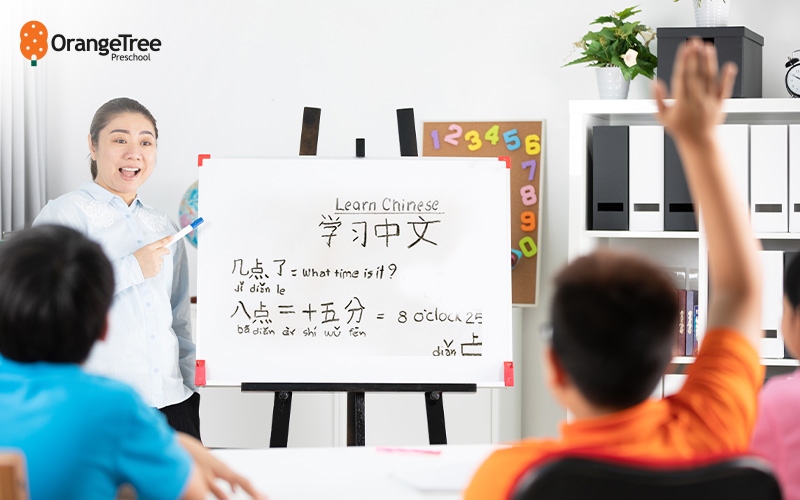
Why Is Bilingualism Important Today?
As global communication becomes seamless and multicultural workplaces become the norm, early language exposure is increasingly seen as a cornerstone of future-ready education.
Many countries, including Singapore, have embraced this shift by introducing a bilingual curriculum from preschool onwards. Schools now recognise that early childhood is the ideal time for language acquisition, as young brains are especially responsive to new sounds, grammar structures, and vocabulary.
The rise of bilingualism also reflects the broader diversity of today’s population. With millions of children growing up in multilingual households, education systems are evolving to reflect this reality. In fact, in many parts of the world, bilingualism is fast becoming the default rather than the exception.
When Should You Start Teaching a Second Language?
The ideal time to introduce a second language is during early childhood, particularly from birth to around age six. This is when the brain is most flexible—forming neural connections quickly and absorbing sounds, patterns, and structures with ease. Known as the critical period for language development, this stage offers a natural window of opportunity for children to learn two languages simultaneously without confusion or stress.
Research has shown that babies as young as 4 to 5 months old can recognise and respond more positively to the sounds of a language they’ve consistently heard. This early familiarity sets the foundation for future language learning.
By the time children reach age 2, many can already distinguish between languages and begin using them appropriately depending on the speaker or social setting. This ability to code-switch, or shifting between languages with ease, is one of the hallmarks of early bilingual development.
Besides, starting early also supports:
- Native-like Pronunciation
Children are better at mimicking sounds and accents when they begin young.
- Richer Vocabulary Development
Early exposure allows words and meanings to develop in both languages simultaneously.
- Long-term Fluency
Early learners are more likely to maintain bilingual skills into adulthood, especially when both languages are used regularly.
Experts even suggest that introducing a second language during pregnancy can begin building familiarity with the rhythm and melody of the language. By simply speaking, reading, or singing to your baby, the early exposure yields natural and lasting results.
How Bilingual Upbringing Benefits Children
Early language learning is just the beginning. As children grow, the ability to speak and understand two languages shapes how they think, connect with others, and engage with the world around them.
In this section, we will highlight the key benefits of raising bilingual children:
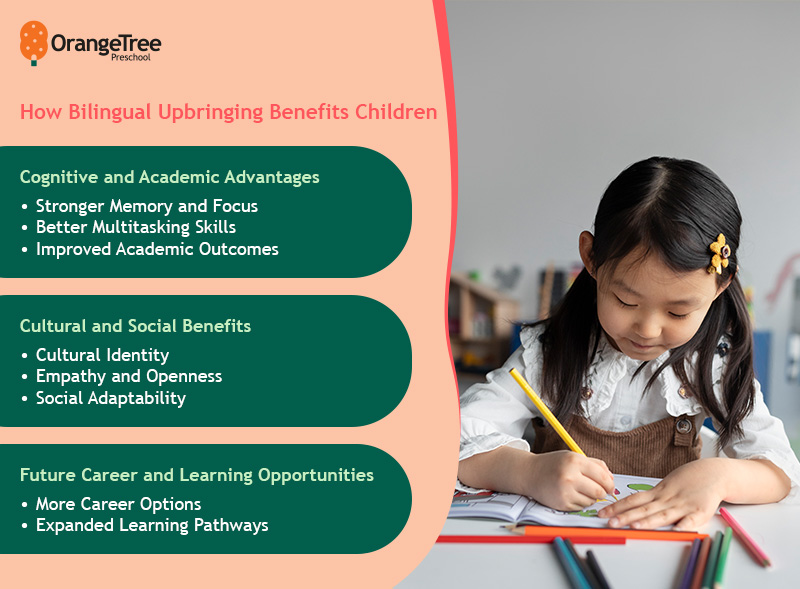 1. Cognitive and Academic Advantages
1. Cognitive and Academic Advantages
Bilingual children often outperform their monolingual peers in several areas of cognitive development. Learning and switching between two languages strengthens the brain’s executive functions, which are responsible for memory, attention, and self-regulation.
- Stronger Memory and Focus
Bilingual kids tend to retain and recall information more effectively.
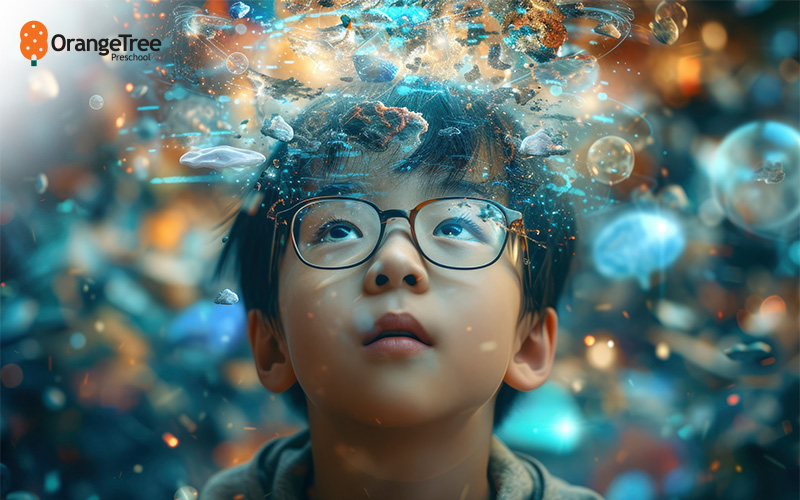
- Better Multitasking Skills
Switching between languages trains the brain to juggle multiple tasks and filter distractions.
- Improved Academic Outcomes
These cognitive benefits translate into stronger performance across subjects, including maths, reading, and science.
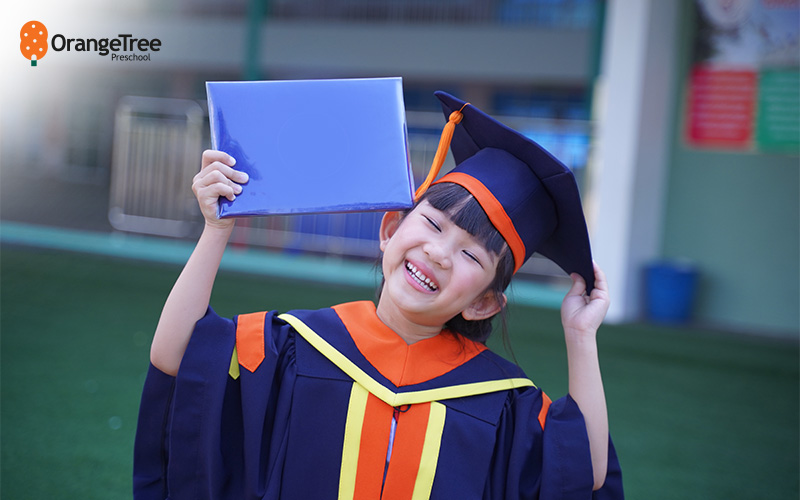
2. Cultural and Social Benefits
Bilingualism is not just about communication—it’s about connection. Children who grow up speaking two languages often develop a richer understanding of their own culture and a deeper appreciation for others.
The meaning of being bilingual is not just about speaking two languages; it also values building meaningful connections. Children raised in bilingual environments often develop a stronger sense of cultural identity and a deeper appreciation for others, allowing them to navigate diverse social settings with empathy and ease.
- Cultural Identity
Being able to speak the language of their heritage strengthens a child’s sense of belonging and family connection.
- Empathy and Openness
Exposure to multiple cultures fosters open-mindedness, helping children relate to people from different backgrounds.
- Social Adaptability
Bilingual children often feel more at ease navigating multicultural settings, making friends, and participating in diverse communities.
3. Future Career and Learning Opportunities
As the world becomes more interconnected, individuals who can navigate multiple languages hold a clear advantage. From cross-border collaboration to culturally nuanced communication, the meaning of bilingual fluency goes beyond language— it becomes a professional asset in fields like business, education, technology, and international relations.
- More Career Options
Candidates who are fluent in more than one language are given a competitive edge in both local and international job markets.
- Expanded Learning Pathways
Bilingualism opens access to overseas education, exchange programmes, and scholarship opportunities that might otherwise be out of reach.
How Is Singapore Emphasising the Meaning of Being Bilingual from an Early Age?
Mother tongue languages (MTL) are vital in shaping identity, cultural understanding, and communication skills. As Singapore continues to emphasise bilingualism, new initiatives are being introduced to strengthen the learning of mother tongue languages across different stages of education.
At the 13th Mother Tongue Languages Symposium held on 14 September 2024, the Ministry of Education (MOE) revealed the goal of deepening students’ connection to their heritage languages. One key area of focus is expanding mother tongue language exposure in preschool.
1. Expanding Access to Higher Mother Tongue Language (HMTL) in Secondary Schools
To support students with a strong interest and aptitude in MTL, MOE will broaden access to Higher Mother Tongue Language at the secondary level. This move aims to provide more students with opportunities to further deepen their proficiency and appreciation for their cultural roots, while also preparing them for advanced language learning pathways.
2. Structured Reading Programme in Primary Schools
A new reading programme will be introduced in primary schools to instil a love for MTL from a young age. The initiative will promote strong reading habits by exposing students to engaging, age-appropriate content in their respective mother tongue languages. By making reading enjoyable and accessible, this programme aims to create a positive foundation for language use and understanding.
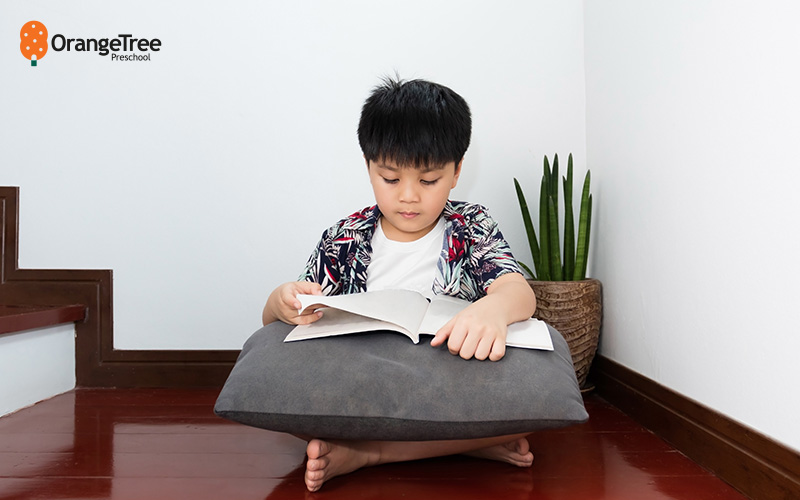
3. Increased Mother Tongue Language Exposure in MOE Kindergartens
Recognising the importance of early childhood bilingual education, MOE will launch a pilot programme to increase mother tongue language exposure in preschool settings, specifically within MOE Kindergartens (MKs).
Through enriched classroom interactions, storytelling, songs, and play-based activities in MTL, the goal is to spark interest, build familiarity, and create a joyful learning experience for young children. Starting MTL learning early lays the groundwork for smoother progression into primary and secondary school MTL programmes.
Building Bilingual Foundations and Shaping Early Language Development
What Does a Bilingual Curriculum Look Like?
While we often think of a bilingual curriculum as simply teaching two languages, it’s truly about creating an environment where both languages are integrated into the flow of everyday learning experiences. By helping children understand the true meaning behind bilingual lessons, educators aim to build the foundation for strong communication skills and deeper cultural appreciation.
In bilingual preschool programmes in Singapore, language learning happens naturally through a variety of engaging, age-appropriate experiences. Here’s how it typically unfolds:
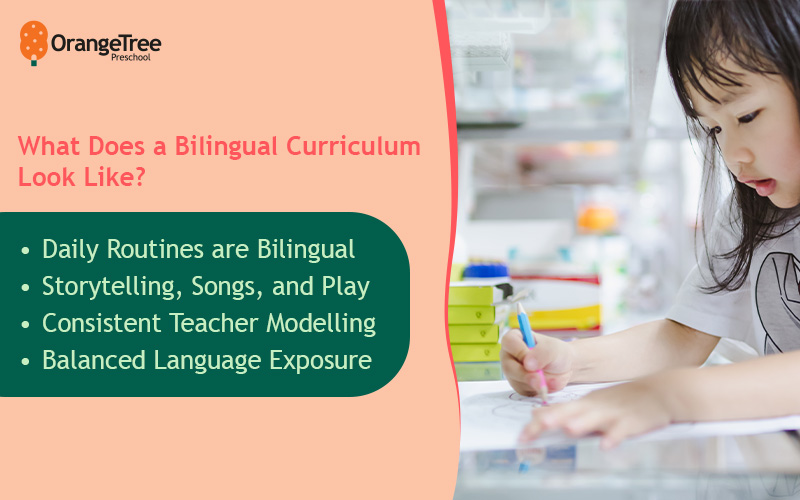
-
Daily Routines are Bilingual
From greetings to mealtime conversations, both languages are used in familiar contexts, helping children associate language with everyday life.
-
Storytelling, Songs, and Play
Teachers use music, picture books, role-play, and games to immerse children in both languages. These playful approaches make language learning fun and intuitive.
-
Consistent Teacher Modelling
Educators use clear, expressive language in both tongues, guiding children to build vocabulary, sentence structure, and conversational skills in context.
-
Balanced Language Exposure
Some bilingual immersion preschools structure their day by language (e.g., English in the morning, Mother Tongue Language in the afternoon), while others integrate both throughout activities, depending on the topic and setting.
How Does an Educator Promote Bilingual Development?
While structured programmes and curriculum matter, a child’s bilingual journey is most successful when supported by both educators and parents. They guide children to find meaning in the words they use, supporting the development of bilingual confidence and understanding across different settings.
1. Supporting Language Through Play
Play is one of the most powerful tools for language learning. Educators can promote bilingual language development in preschoolers through responsive interactions. For example, during pretend cooking, a teacher might say, “You’re making noodles! 你在煮面条!” (nǐ zài zhǔ miàn tiáo). This type of context-based language modelling helps children understand how both languages are used meaningfully in real life.
2. Observation and Individual Support
No two children learn languages in exactly the same way. By closely observing each child’s interests, teachers can tailor activities to match their curiosity. Creating space for shared storytelling, role-play, or group discussions helps children express themselves in both languages while feeling seen and supported. The key is to encourage participation and scaffold understanding, rather than focusing solely on correctness.
How Do Parents Encourage Bilingualism at Home?
1. Create a Language-Rich Environment
Language thrives where it’s part of everyday life. Surround your child with books, songs, conversations, and play in both languages. Simple moments like mealtime, bathtime, or bedtime can become powerful learning opportunities, helping children uncover the meaning of bilingual speech in day-to-day situations.
For instance, during mealtime, you might say, “Do you want rice or noodles?” followed by “你想吃饭还是面?” (nǐ xiǎng chī fàn hái shì miàn?). These simple, consistent exposures help children link vocabulary across both languages effortlessly.
2. Maintain Consistency with the OPOL Method
The One Person, One Language (OPOL) method is a popular strategy where each caregiver consistently uses one language with the child. This helps young learners clearly associate each language with a specific person, reducing confusion and encouraging balanced exposure.
However, flexibility is important. Some children may favour one language or need extra support in the other. That said, adapting based on their needs ensures better outcomes.
3. Use Media as a Learning Tool
Technology, when used mindfully, can support bilingual development. Watching cartoons, short videos, or storybooks in both languages helps reinforce vocabulary, listening, and even reading skills.
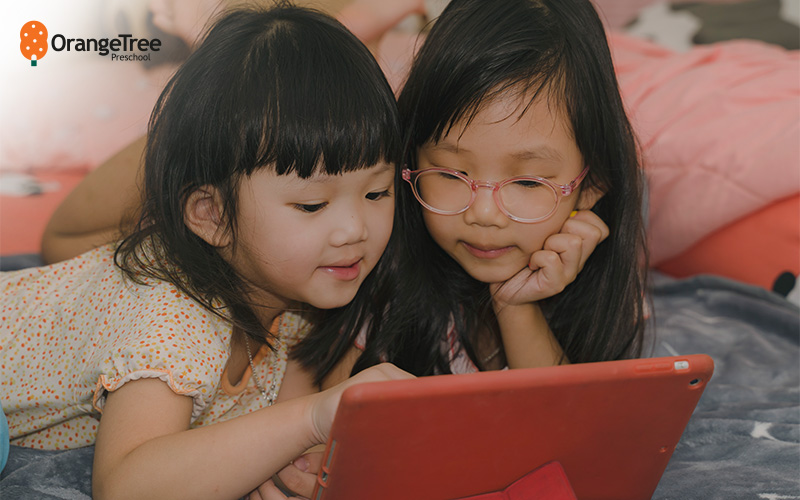
Meanwhile, subtitled shows are particularly useful, as children begin connecting spoken and written language. Re-watching familiar content in both languages also boosts comprehension and confidence.
Together, educators and parents can create a consistent, immersive bilingual environment. When exploring how to raise a bilingual child, it’s this blend of home and school support that makes language learning feel natural, meaningful, and lasting.
Debunking the Myths About the Meaning of Bilingual Development: What are Some Common Concerns Among Parents?
1. “Will Learning Two Languages Confuse My Child?”
Many parents worry that introducing two languages early might overwhelm their child or delay speech development. However, by truly grasping the meaning of bilingual learning, they can quickly separate and use each language appropriately.
2. “What If My Child Mixes the Two Languages?”
Language mixing (code-switching) is a normal part of development as it reflects a growing understanding of the meaning behind being bilingual. In fact, this usually resolves as the child starts gaining more proficiency in both languages.
3. “Will Learning Two Languages Delay My Child’s Speech?”
Bilingual children may start speaking slightly later, but this is within the normal developmental range and not a sign of delay.
Frequently Asked Questions
1. What’s the difference between simultaneous and sequential bilingualism?
Simultaneous bilingualism occurs when a child learns two languages from birth. Sequential bilingualism happens when a second language is introduced after the first is established, typically after age 3.
2. What kind of preschools support bilingualism in Singapore?
Many preschools in Singapore offer dual-language programmes, typically in English and Mandarin. Look for schools with structured bilingual curricula and native-speaking educators.
3. Is it okay if my child prefers one language over the other?
Yes. Language dominance is normal and often depends on exposure. With balanced practice and support, your child can better understand the meaning of bilingual education, growing confident in both languages over time.
Conclusion
Being bilingual carries a deeper meaning—it grants your children a lifelong gift to connect, think critically, and thrive in a global world. Early exposure—especially in a nurturing Chinese preschool environment—lays the foundation for fluency, cultural appreciation, and confident communication in both languages.
At Orange Tree Preschool, we embrace this journey through a structured, child-centred approach aligned with ECDA guidelines. Our warm, enriching setting supports children’s growth in both English and Chinese, balancing academics with play and emotional development.
Contact us and let us make bilingual learning meaningful for your child.
